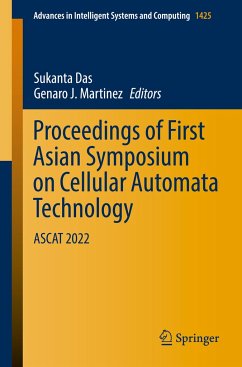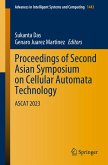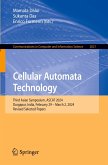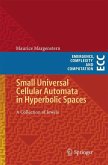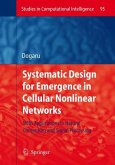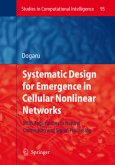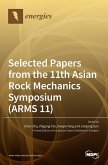Proceedings of First Asian Symposium on Cellular Automata Technology
ASCAT 2022
Herausgegeben:Das, Sukanta; Martinez, Genaro J.
Proceedings of First Asian Symposium on Cellular Automata Technology
ASCAT 2022
Herausgegeben:Das, Sukanta; Martinez, Genaro J.
- Broschiertes Buch
- Merkliste
- Auf die Merkliste
- Bewerten Bewerten
- Teilen
- Produkt teilen
- Produkterinnerung
- Produkterinnerung
This book gathers selected research papers presented at the First Asian Symposium on Cellular Automata Technology (ASCAT 2022), organized online by academicians from Kolkata, India, during March 3-5, 2022. The book presents one of the most emergent areas in natural computing, cellular automaton (CA). CA is a paradigm of uniform fine-grained parallel computation which has been explored to understand complex systems by developing its model at the microscopic level. The book discusses many real-life problems in the domain of very large-scale integration (VLSI) design and test, pattern recognition…mehr
Andere Kunden interessierten sich auch für
![Proceedings of Second Asian Symposium on Cellular Automata Technology Proceedings of Second Asian Symposium on Cellular Automata Technology]() Proceedings of Second Asian Symposium on Cellular Automata Technology161,99 €
Proceedings of Second Asian Symposium on Cellular Automata Technology161,99 €![Cellular Automata Technology Cellular Automata Technology]() Cellular Automata Technology117,99 €
Cellular Automata Technology117,99 €![Small Universal Cellular Automata in Hyperbolic Spaces Small Universal Cellular Automata in Hyperbolic Spaces]() Maurice MargensternSmall Universal Cellular Automata in Hyperbolic Spaces110,99 €
Maurice MargensternSmall Universal Cellular Automata in Hyperbolic Spaces110,99 €![Systematic Design for Emergence in Cellular Nonlinear Networks Systematic Design for Emergence in Cellular Nonlinear Networks]() Radu DogaruSystematic Design for Emergence in Cellular Nonlinear Networks74,99 €
Radu DogaruSystematic Design for Emergence in Cellular Nonlinear Networks74,99 €![Designing Beauty: The Art of Cellular Automata Designing Beauty: The Art of Cellular Automata]() Designing Beauty: The Art of Cellular Automata37,99 €
Designing Beauty: The Art of Cellular Automata37,99 €![Systematic Design for Emergence in Cellular Nonlinear Networks Systematic Design for Emergence in Cellular Nonlinear Networks]() Radu DogaruSystematic Design for Emergence in Cellular Nonlinear Networks74,99 €
Radu DogaruSystematic Design for Emergence in Cellular Nonlinear Networks74,99 €![Selected Papers from the 11th Asian Rock Mechanics Symposium (ARMS 11) Selected Papers from the 11th Asian Rock Mechanics Symposium (ARMS 11)]() Selected Papers from the 11th Asian Rock Mechanics Symposium (ARMS 11)51,99 €
Selected Papers from the 11th Asian Rock Mechanics Symposium (ARMS 11)51,99 €-
-
-
This book gathers selected research papers presented at the First Asian Symposium on Cellular Automata Technology (ASCAT 2022), organized online by academicians from Kolkata, India, during March 3-5, 2022. The book presents one of the most emergent areas in natural computing, cellular automaton (CA). CA is a paradigm of uniform fine-grained parallel computation which has been explored to understand complex systems by developing its model at the microscopic level. The book discusses many real-life problems in the domain of very large-scale integration (VLSI) design and test, pattern recognition and classification, cryptography, pseudo-random pattern generation, image processing, sensor networks, material science, etc., by using CA.
Produktdetails
- Produktdetails
- Advances in Intelligent Systems and Computing 1425
- Verlag: Springer / Springer Nature Singapore / Springer, Berlin
- Artikelnr. des Verlages: 978-981-19-0541-4
- 1st ed. 2022
- Seitenzahl: 264
- Erscheinungstermin: 28. April 2022
- Englisch
- Abmessung: 235mm x 155mm x 15mm
- Gewicht: 406g
- ISBN-13: 9789811905414
- ISBN-10: 981190541X
- Artikelnr.: 63353714
- Herstellerkennzeichnung Die Herstellerinformationen sind derzeit nicht verfügbar.
- Advances in Intelligent Systems and Computing 1425
- Verlag: Springer / Springer Nature Singapore / Springer, Berlin
- Artikelnr. des Verlages: 978-981-19-0541-4
- 1st ed. 2022
- Seitenzahl: 264
- Erscheinungstermin: 28. April 2022
- Englisch
- Abmessung: 235mm x 155mm x 15mm
- Gewicht: 406g
- ISBN-13: 9789811905414
- ISBN-10: 981190541X
- Artikelnr.: 63353714
- Herstellerkennzeichnung Die Herstellerinformationen sind derzeit nicht verfügbar.
Sukanta Das currently works as Associate Professor and Head, Department of Information Technology in Indian Institute of Engineering Science and Technology, Shibpur (formerly known as Bengal Engineering and Science University, Shibpur). He received his Ph.D. in 2007 from Bengal Engineering and Science University, Shibpur (Currently known as IIEST, Shibpur) in Computer Science and Technology. He has been doing research in the different aspects of cellular automata for more than twenty years. His research area includes cellular automata: theory and applications. He is also Member of IFIP Working Group 1.5 (on "Cellular Automata and Discrete Complex Systems") and several programming committees for international conferences on cellular automata. He has more than 70 articles under his name. Currently, he is exploring the computational abilities of cellular automata, the non-uniform cellular automata, (partial) number conservation in cellular automata, and chaos and randomness in cellular automata. Genaro Martínez is Full-Time Researcher at the National Polytechnic Institute in Mexico City. He is Active Member of several institutions and laboratories around the world, such as: the International Unconventional Computing Laboratory at the University of the West of England in the UK; the Foundation of Computer Science Laboratory at the Hiroshima University in Japan; the Centre for Chaos and Complex Networks at the City University of Hong Kong in China; the Unconventional Algorithms and Computing Lab at the Technical University of Ostrava in Czech Republic; the Laboratoire de Recherche Scientifique in France; and at the Institut des Systèmes Complexes en Normandie in France. He is Editorial Member of the Journal of Cellular Automata, Complex Systems, Physica D, International Journal of Bifurcation and Chaos, Artificial Life, Nonlinear Dynamics, Chaos, Information Sciences, International Journal of Natural Computing Research, IEEE Transactions on Circuits and Systems, and the Mathematical Reviews, American Mathematical Society. He together with Prof. Adamatzky had published the book "Designing Beauty: The Art of Cellular Automata." Also, he is leading two computational paradigms in cellular automata theory: colliders cellular automata and computation by competing patterns with cellular automata.
Part I: Invited Papers.- Computing in a Simple Reversible and Conservative Cellular Automaton.- Algorithms for Group Cellular Automata.- Revisiting Logic Obfuscation Using Cellular Automata.- Part II: Accepted Papers.- Grade Estimation of Mineral Resources: An Application of Cellular Automata.- Shape Generation using Cellular Automata with Clustering.- Evolution Patterns of Some One-Dimensional Non-uniform Cellular Automata.- Relationship of Two Discrete Dynamical Models: One-dimensional Cellular Automata and Integral Value Transformations.- Emulating Mersenne Twister with Cellular Automata.- Defining Reachability Tree under Adiabatic and Reflexive Boundary Condition Cellular Automata.- First Degree Cellular Automata as Pseudo-random Number Generators.- Asynchronous Cellular Automata as Randomness Enhancer.- Cellular-automata based simulation of dynamic recrystallization and statistical analysis of resulting grain growth.- A new notion of universality in respect of logic gates generation capability of ECAs.- Impact of Genetic Algorithm on Low power QCA Logic Circuit with Regular Clocking.- Cellular automata based model for finding minimum spanning tree in wireless sensor networks.- A Novel Hash Function based on Hybrid Cellular Automata and Sponge Functions.- Synthesis of Single Length Cycle Two Attractor CA using NSRT Diagram. Suvadip Hazra and Mamata Dalui.
Part I: Invited Papers.- Computing in a Simple Reversible and Conservative Cellular Automaton.- Algorithms for Group Cellular Automata.- Revisiting Logic Obfuscation Using Cellular Automata.- Part II: Accepted Papers.- Grade Estimation of Mineral Resources: An Application of Cellular Automata.- Shape Generation using Cellular Automata with Clustering.- Evolution Patterns of Some One-Dimensional Non-uniform Cellular Automata.- Relationship of Two Discrete Dynamical Models: One-dimensional Cellular Automata and Integral Value Transformations.- Emulating Mersenne Twister with Cellular Automata.- Defining Reachability Tree under Adiabatic and Reflexive Boundary Condition Cellular Automata.- First Degree Cellular Automata as Pseudo-random Number Generators.- Asynchronous Cellular Automata as Randomness Enhancer.- Cellular-automata based simulation of dynamic recrystallization and statistical analysis of resulting grain growth.- A new notion of universality in respect of logic gates generation capability of ECAs.- Impact of Genetic Algorithm on Low power QCA Logic Circuit with Regular Clocking.- Cellular automata based model for finding minimum spanning tree in wireless sensor networks.- A Novel Hash Function based on Hybrid Cellular Automata and Sponge Functions.- Synthesis of Single Length Cycle Two Attractor CA using NSRT Diagram. Suvadip Hazra and Mamata Dalui.

